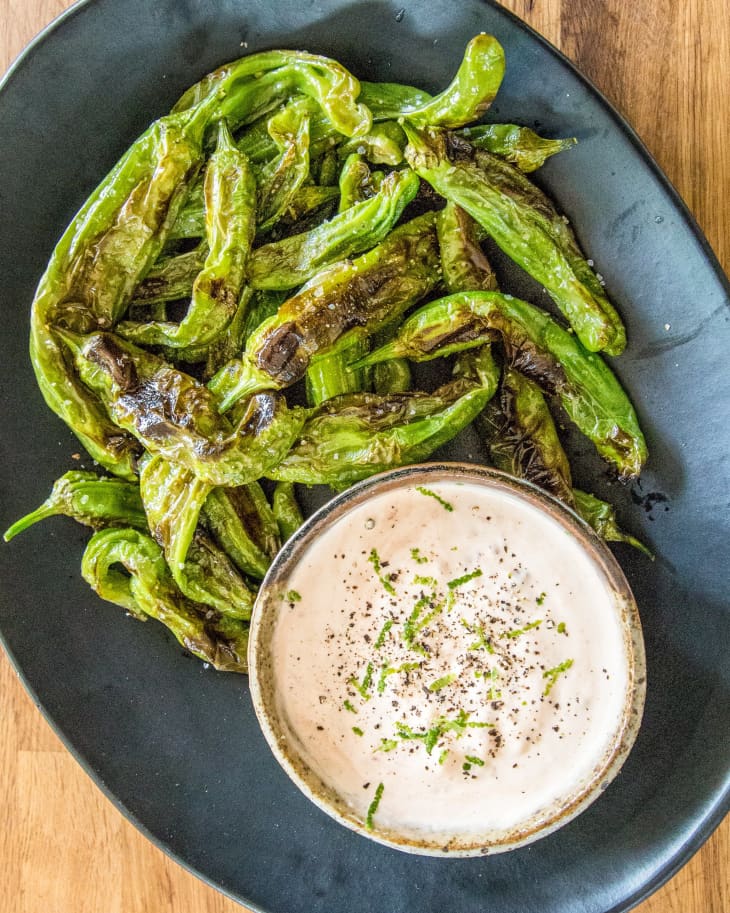How To Roast Shishito Peppers

Serves4 to 6
Mark my words: This is the easy, crowd-pleasing appetizer I will be serving all summer long. Blistered shishito and padron peppers (they’re basically interchangeable here) are so much more addictive than you might expect from such a simple dish. It’s something about the interplay of crunchy salt, rich oil, and smoky peppers — you can’t stop at just one.
Or maybe the addictiveness comes from the fact that you’re playing Russian roulette with every bite — there are a few mega-spicy interlopers in every batch of otherwise mellow peppers, but there’s no telling which ones.
Buying Shishito or Padron Peppers
You can use either Japanese shishito or Spanish padron peppers for this dish. They look nearly identical and both have a mellow, slightly sweet flavor — except for the occasional spicy surprise! Roughly one pepper in every handful will buck the norm and set your mouth (pleasantly) on fire.
Look for peppers between two inches and five inches long that are bright green and very firm. They are usually available fresh in grocery stores and farmers markets well into the fall, though you can often find packages of shishito peppers at Asian grocery stores year-round. Keep them in a crisper drawer in your fridge until ready to eat; they’ll be fine for a few days until you get around to roasting them.
High Heat & Quick Cooking for the Best Peppers
The key to fantastic roasted peppers is high heat and quick cooking. The higher and quicker the better. You’re aiming for charred blisters on all sides and a texture that is still fairly firm. Cook the peppers too slowly or at lower heat and they tend to wilt and become too soft before they develop charred spots.
Personally, I prefer roasting the peppers in a scorching hot skillet under the broiler. This way you get simultaneous charring on the top and bottoms, and a lot less smoke. This said, sometimes even turning on the broiler for five minutes of quick cooking is too much during the summer — for those moments, it’s the stovetop with the kitchen window wide open to vent smoke.
If you have a grill, by all means use it for roasting peppers! The peppers are so small that they’ll fall between the grates, so definitely use a pre-heated grill pan.
Serve Roasted Peppers Right Away
These peppers are best sprinkled with crunchy salt and eaten within minutes of coming off the heat. Even with high heat and quick cooking, they’ll wilt and lose their crispiness the longer they sit.
Serve the peppers with a cool, creamy dipping sauce to tame the heat of those few spicy specimens. This Magic Summer Sauce is a favorite; I swap out the yogurt for sour cream or mayo (or a mix) when I want something a little more indulgent.
How To Roast Shishito Peppers
Serves 4 to 6
Nutritional Info
Ingredients
- 2 dry pints
shishito or padron peppers
- 1 tablespoon
cooking oil (see Recipe Notes)
Coarse kosher salt or sea salt
Equipment
Mixing bowl
10-inch or larger cast iron or stainless steel skillet (do not use nonstick)
Heatproof spatula or tongs
Instructions
Heat the skillet: Place a large skillet under the broiler or on the stovetop over high heat to warm.
Oil the peppers: Place the peppers in a mixing bowl. Drizzle them with cooking oil and a healthy sprinkle of salt. Use your hands or a spatula to toss the peppers until evenly coated.
Transfer the peppers to the skillet: When the skillet is hot enough that a flick of water evaporates instantly, pour the peppers into the skillet. Be careful — the pan is very hot! The peppers should start to sizzle immediately.
Cook the peppers until blistered: Transfer the skillet with peppers back beneath the broiler, or continue cooking over medium-high heat on the stovetop. (If cooking on the stovetop, turn on a vent fan.) Cook the peppers without moving them for a few minutes so they char on the bottom, then stir with a spatula. Continue cooking and stirring every minute or two until the peppers are blistered and darkened all over, 5 to 6 minutes total.
Transfer the peppers to a plate and sprinkle with extra salt: The peppers are best when eaten within minutes of coming off the heat. Have a bowl of dipping sauce ready!
Recipe Notes
Cooking oil: I prefer to use olive oil for this dish, though technically olive oil isn't ideal for this kind of high-heat cooking. I just love its rich, savory flavor with the salty peppers. If you'd prefer to use something else, I'd go for grapeseed oil or even peanut oil.
Dipping sauce: Make a simple dipping sauce for these peppers by mixing mayonnaise, sour cream, or yogurt with some lime or lemon juice and some hot sauce, like our Magic Summer Sauce.
